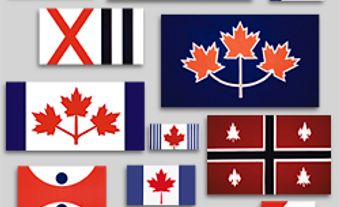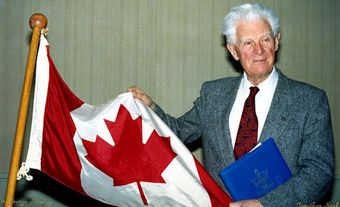The Canadian Red Ensign was the de facto Canadian national flag from 1868 until 1965. It was based on the ensign flown by British merchant ships since 1707. The three successive formal designs of the Canadian Red Ensign bore the Canadian coats of arms of 1868, 1921 and 1957. In 1891, it was described by the Governor General, Lord Stanley, as “the Flag which has come to be considered as the recognized Flag of the Dominion both afloat and ashore.” Though it was never formally adopted as Canada’s national flag, the Canadian Red Ensign represented Canada as a nation until it was replaced by the maple leaf design in 1965.

Background
Ensign is a generic term for a flag commonly used to indicate the nationality of a ship. It is often “a derivative of a national flag and thus subordinate to it.” The Canadian Red Ensign was a derivative of the Red Ensign flown by the British merchant marine. In the words of one historian, it was therefore “arguably a derivative of a derivative.”
The Red Ensign proper — a red flag with the Royal Union Flag (Union Jack) in the upper left corner (the canton) next to the flagpole — had been flown by British merchant ships since 1707. Within colonial Canada, the ensign was used as a sign of Royal authority. Variants were flown from the forts and canoes of the fur-trading Hudson’s Bay Company (bearing the letters HBC) from 1682; as well as the North West Company (NWC) from 1779.

Initial Adoption and Usage
The Canadian Red Ensign was authorized for use by Canadian-registered merchant ships by an Admiralty warrant issued on 2 February 1892. It bore the coat of arms issued in 1868; this coat of arms contained the arms of Ontario, Quebec, New Brunswick and Nova Scotia on the half farthest from the flagpole (the fly). (See also Provincial and Territorial Emblems.)
By 1892, the Ensign had already been used unofficially for more than two decades to represent Canada at sea and on land. Several designs were unofficially produced before and after 1892. Some bore the coats of arms of all the provinces in Confederation at that time (not just the original four provinces); others depicted the arms surrounded by a wreath of maple leaves, or maple and oak leaves, surmounted by a beaver, or topped by a crown with a wreath of roses, thistles and shamrocks.
By the early 20th century, however, the Canadian Red Ensign was lowered from atop the Parliament Buildings. It was replaced by the Union Jack during a period of imperial ascendancy; this was brought on, in part, by Queen Victoria’s Diamond Jubilee in 1897 and by the South African War.
Many veterans reported seeing the Canadian Red Ensign being carried by Canadian soldiers during the First World War; even though, officially, Canada fought under the Union Jack. In one example, Lieutenant-Colonel Lorn Tudor, commanding officer of the 5th Canadian Infantry Battalion, carried an Ensign, likely in his pack, during several battles in 1917, including the assault on Vimy Ridge. Donated to the Imperial War Museum, this particular Ensign was loaned to the Canadian War Museum from 2005 to 2008. It was then returned to London.

Development of the Design and Usage
In 1921, a distinctive Canadian coat of arms was authorized. An order-in-council was issued on 26 April 1922 authorizing the placement of this coat of arms on the Canadian Red Ensign. This became the second official design of the flag.
On 26 January 1924, another order-in-council authorized the display of the Canadian Red Ensign on “all buildings owned or occupied by the Canadian Government and situated without Canada.” As a result, the Ensign replaced the Canadian Blue Ensign. It had previously flown over the Canadian High Commission in London.

During the Second World War on 10 November 1943, the Royal Canadian Air Force (RCAF) ordered that the Canadian Red Ensign “be flown in addition to the RCAF Ensign, at all units of the RCAF serving with forces of other nations.” A few months later, on 22 January 1944, the Canadian Army directed that the Ensign be flown by all Canadian Army units when serving “with forces of other nations.”
On 5 September 1945, an order-in-council extended the authorization to use the Ensign on federal government buildings within Canada and abroad. This included lowering the Union Jack from atop the Peace Tower in Ottawa. It had been flying there for over 40 years. The Canadian Red Ensign (the new design bearing the 1921 coat of arms) was raised in its place. The same order dictated it would be appropriate to fly the Ensign “wherever place or occasion make it desirable to fly a distinctive Canadian flag.” This stipulation remained in effect until Parliament adopted an official national flag in 1965.
On 8 October 1957, the Canadian government made a change to the Canadian coat of arms; the colour of the three maple leaves depicted was changed from green — as introduced in the 1921 arms — to red, in keeping with Canada’s national colours (red and white). The new arms were also depicted on the Ensign — its third, and final, official design.

Controversy and Legacy
During the federal election campaign of 1963, Liberal Party leader Lester B. Pearson promised to introduce a distinctive national flag for Canada. The ensuing debate, ultimately leading to the design and adoption of the maple leaf flag, was contentious. (See The Great Flag Debate.) On one hand, defenders of the Canadian Red Ensign and its symbolic ties to Great Britain — including Progressive Conservative leader and former Prime Minister John Diefenbaker — argued for its retention. On the other, myriad alternate designs were offered as replacements for the Ensign. The result was the maple leaf national flag. On 15 February 1965, the Ensign was officially retired. It was lowered on Parliament Hill and hundreds of locations elsewhere and replaced by the new flag.
However, the use of the Red Ensign or the Union Jack did not entirely disappear in Canada; the provincial governments of Manitoba and Ontario introduced Red Ensign–based provincial flags for their provinces a few months after the new Canadian flag was raised. British Columbia had already introduced a variant of the Union Jack in its provincial flag in 1960. Newfoundland and Labrador continued to use the Union Jack until 1980, when it was replaced with a stylized Union Jack as part of its new design.
See also National Flag of Canada; Editorial: The Canadian Flag, Distinctively Our Own; Editorial: The Stanley Flag and the “Distinctively Canadian Symbol”; Flag Songs; Emblems of Canada; Heraldry.


 Share on Facebook
Share on Facebook Share on X
Share on X Share by Email
Share by Email Share on Google Classroom
Share on Google Classroom





